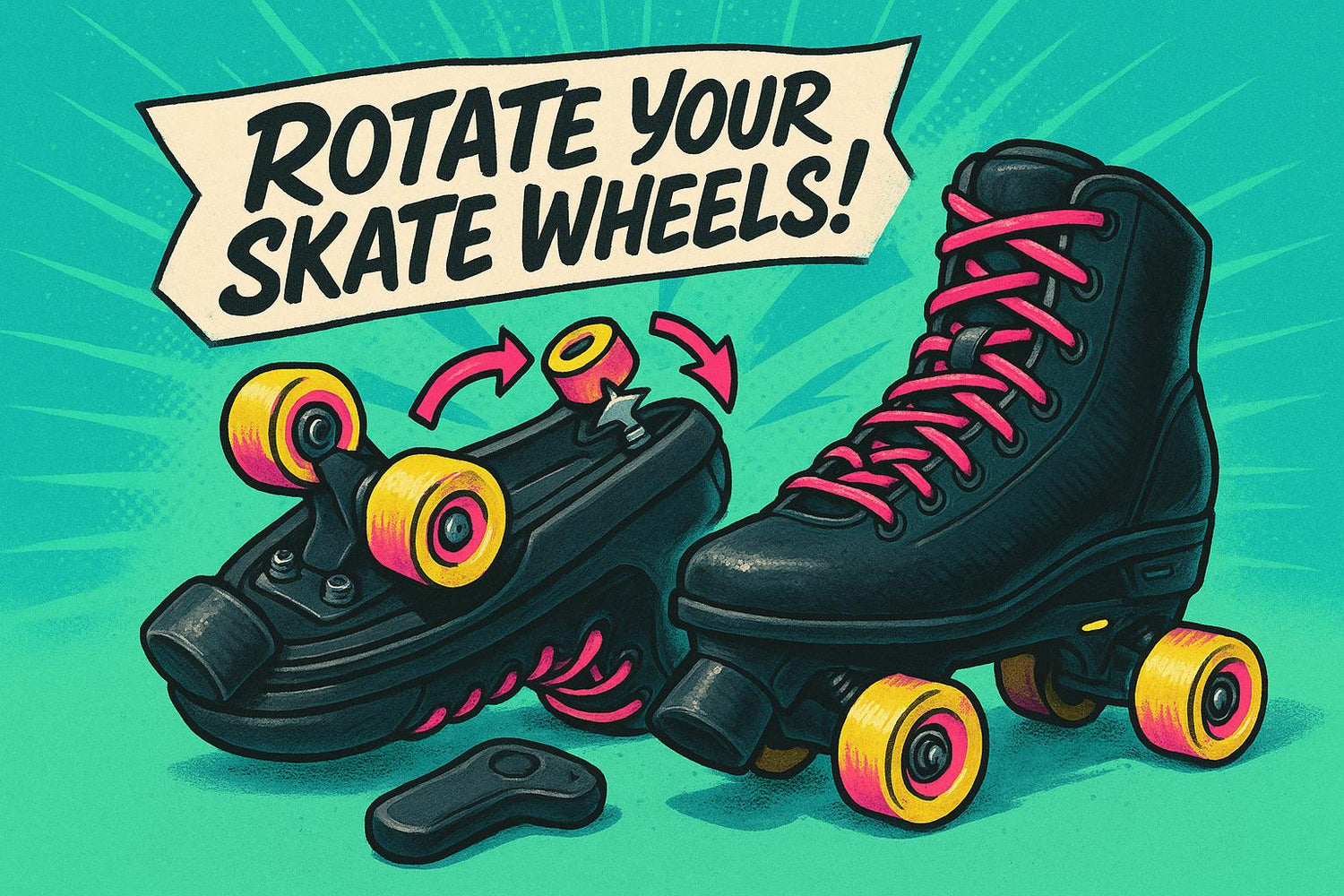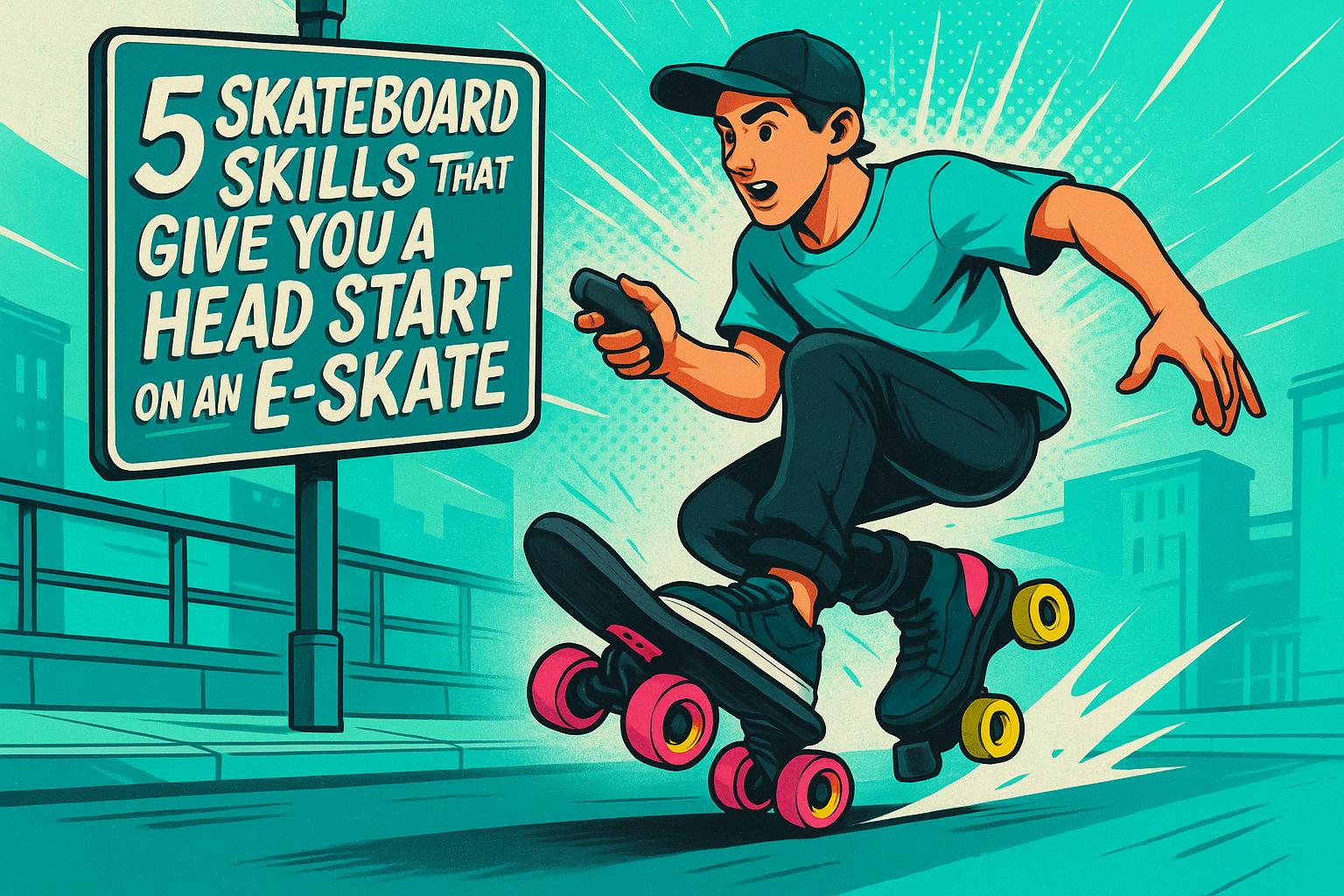Rotating your skate wheels is essential for keeping your ride smooth and extending the life of your wheels. Over time, wheels wear unevenly due to stress from turning, braking, and acceleration. This can lead to vibrations, wobbles, and reduced performance. Regular rotation ensures even wear, improves balance, and helps you get the most out of your skates.
Key Steps to Rotate Your Wheels:
- Tools You Need: A skate tool or hex key, clean cloth, and optional items like lubricant and a soft brush.
- Spot Uneven Wear: Look for signs like coning, flat spots, or size differences.
- Rotation Patterns: Use an X-pattern for 4-wheel setups or swap front and rear wheels for 3-wheel setups.
- Reinstallation: Align wheels properly, tighten bolts, and test for smooth rotation.
Maintenance Tips:
- Inspect wheels every 10–15 sessions or monthly for outdoor use.
- Avoid hard braking and balance your weight to reduce stress on specific wheels.
- Clean and lubricate bearings during rotations for optimal performance.
How to rotate inline skate wheels - flat 4 wheel setup - easy method to rotate rollerblade wheels
Tools and Materials You Need
Having the right tools on hand before starting makes rotating the wheels on your Wheelfeet electric roller skates much simpler and safer. Here’s a breakdown of the must-have tools and a few extras that can streamline the process.
Required Tools
The most critical tool in your kit will be a skate tool or hex key set. Most Wheelfeet skates use standard hex bolts (also called Allen bolts) to secure the wheels, typically in 4 mm or 5 mm sizes. A multi-tool skate key with both hex and Phillips head options will cover all your fastening needs. These tools are affordable, usually priced between $10 and $20.
You’ll also need a clean cloth or rag to wipe down the wheels and bearings during the process. This step helps you clearly see wear patterns and prevents dirt from contaminating the bearing housing when reassembling your skates.
If you’re planning to clean the bearings while rotating the wheels, a good bearing lubricant is essential. Thin bearing grease works best - options like Bones Speed Cream, Sabre Bearing Lube, or Tri Flow are great choices. These lubricants, costing around $8–$15, reduce wear and keep your skates performing smoothly. For skating in wet conditions, thicker marine or engine grease provides extra protection.
Extra Items That Help
A few additional tools can make the maintenance process even easier and more effective.
- Measuring tape or ruler: Useful for checking wheel diameter and spotting uneven wear patterns, which aren’t always visible at first glance. Measuring ensures a smoother ride by identifying subtle inconsistencies.
- Soft-bristled brush: Handy for cleaning wheels and bearing races, especially if you’ve been skating on dusty or gritty surfaces where debris builds up.
- Citrus degreaser or white spirit: Ideal for deep cleaning bearings. These solvents effectively remove old grease and grime without harming the bearing components. However, avoid using WD-40 as a lubricant - it’s a degreaser and can strip essential lubrication, potentially damaging your bearings if not followed by proper grease.
- Container with a lid: Perfect for soaking bearings during cleaning. It keeps the degreaser contained and makes the process much tidier.
Having all these tools ready before you begin ensures a smooth, uninterrupted rotation process. This preparation not only saves time but also helps maintain even wheel wear for a better skating experience.
How to Spot Uneven Wheel Wear
Catching uneven wheel wear early is key to maintaining smooth performance and safe handling. Regularly inspecting your wheels can help you address issues before they affect your skating experience or lead to costly replacements. Let’s break down what uneven wear looks like and how to check for it.
What Uneven Wear Looks Like
One of the most common signs of uneven wear is coning - when one side of the wheel wears down more than the other. This often affects the outer edge, altering the wheel's cylindrical shape.
Another noticeable pattern is flat spots, which appear as small, flat areas on the wheel's surface. These are usually caused by hard braking or sliding and can make your ride feel bumpy. You might even hear a rhythmic tapping sound while skating if flat spots are present.
Pay attention to the wheel surface for inconsistent textures. Some areas might look glossy while others appear dull, scratched, or even cracked. Over time, you may notice size differences between your wheels. For instance, a skater on r/NewSkaters shared in December 2023 that after switching to Bones 100 wheels for winter, they found one wheel had worn down significantly smaller than the others, creating an uneven ride.
Once you spot these signs, it’s time to do a hands-on check of your wheels.
How to Check Your Wheels
Start with a visual and manual inspection of your mounted wheels. Look at the side profile for any obvious signs of coning or asymmetry. Compare the front, rear, and center wheels to identify any size differences.
Next, spin each wheel. A properly functioning wheel should rotate smoothly and coast for several seconds. If a wheel stops quickly, feels gritty, or makes grinding noises, it could indicate worn bearings or advanced wear.
For a deeper inspection, remove the wheels using your skate tool. This allows you to examine the entire wheel surface and check the bearings. Use a measuring tape or ruler to measure each wheel’s diameter - even a small difference of 1–2 mm (about 1/16 inch) can affect performance. While holding the wheel, roll it in your hand with slight pressure. Feel for any vibrations or rough spots that might indicate flat areas or bearing problems. Also, check for lateral movement or wobbling, as this could mean the bearings are damaged or not seated properly.
Uneven wear can often be linked to your skating style. For example, one edge or the dominant foot may wear down faster. Beginners and intermediate skaters may also notice more wear on the front wheels due to balance and technique.
Incorporate these checks into your regular maintenance routine. Inspect your wheels after every few skating sessions, especially if your skates start to feel less stable or smooth. Catching uneven wear early and rotating your wheels regularly can help prevent long-term damage and keep your skates performing at their best.
sbb-itb-bf837b9
How to Rotate Your Wheels
Once you've spotted uneven wear on your wheels, it's time to rotate them. This simple process helps balance the wear and keeps your wheels lasting longer. Whether you have a 4-wheel or 3-wheel setup, here's how to do it.
Before you begin, ensure your skates are powered off and unplugged from any charging cables. Set up on a clean, flat, and well-lit surface to make the process easier.
4-Wheel Rotation Pattern
For 4-wheel setups, the X-pattern method is your go-to. This approach swaps wheels diagonally across your skates, evening out wear across all four wheels.
Start by removing all the wheels and marking their original positions. Then, follow this rotation:
- Move the left front wheel to the right rear position.
- Shift the right front wheel to the left rear.
- Place the left rear wheel in the right front spot.
- Finally, move the right rear wheel to the left front.
This diagonal swap redistributes the stress each wheel experiences. For instance, front wheels often wear more on the outer edge due to turning. By moving them to the rear, you balance out the wear over time.
If one wheel shows extra wear - often from your dominant foot - place it in a less-stressed position to extend its life.
3-Wheel Rotation Pattern
For 3-wheel setups, an X-pattern isn’t an option, so you'll need a different strategy. The focus here is on front-to-rear swapping and adjusting the center wheel as needed.
Remove all wheels and inspect their wear. Typically, you’ll swap the front and rear wheels on each skate and reposition the center wheel based on its condition. If one center wheel is more worn than the other, move it to the opposite skate to balance the load.
The center wheel often takes the most stress since it carries the majority of the weight while skating. If it’s wearing down faster, consider moving it to a front or rear position.
Alternatively, some skaters prefer a rotation cycle where the front wheel moves to the center, the center shifts to the rear, and the rear goes to the front - all on the same skate. This method works well if wear patterns are consistent across your skates.
Installing Wheels and Final Checks
When putting your wheels back on, proper alignment with the aluminum frame is crucial for smooth performance. Insert each wheel into its new position, ensuring the bearing sits flush against the frame. Thread the axle bolt by hand first, then use your skate tool to tighten it. The wheel should spin freely without wobbling but shouldn’t feel loose when moved side to side.
After reinstalling all the wheels, spin each one to check for smooth rotation. If a wheel stops quickly or makes noise, remove it and inspect the bearing alignment.
Test the regenerative braking system by gently activating it while the wheels spin. This ensures the electrical connections are intact after the rotation. The braking should engage smoothly without any jerks or strange sounds.
Finally, confirm that all wheels are evenly spaced from the frame and properly aligned. Misaligned wheels can throw off your balance and affect the performance of your skates’ speed settings. Take a few slow test rolls to ensure everything feels stable before heading out for a full skate session.
Tips for Even Wheel Wear
Keeping your wheels in good shape goes beyond just rotating them. With proper maintenance and mindful riding habits, you can significantly extend the life of your Wheelfeet skate wheels and keep them performing at their best.
When to Check and Rotate Wheels
Make it a habit to check your wheels regularly - about every 10–15 skating sessions. If you're skating outdoors on soft wheels, aim for a monthly inspection and rotation. For harder wheels or indoor use, a rotation every four months should do the trick.
The type of wheel material makes a big difference in how often you should rotate. Softer wheels, which are common for outdoor skating, wear down faster on rough surfaces like asphalt and concrete. If you're commuting on your Wheelfeet skates outdoors, a monthly rotation schedule is a smart move.
"Some sources recommend once a month, to be safe. I personally skate harder, 101A wheels. I stick to relatively smooth surfaces, so I only rotate mine about every 4 months." - Medusa Skates
Skating indoors or on smooth, well-maintained paths? You can stretch the rotation interval to about four months. These conditions are much gentler on your wheels compared to the wear and tear of rough city streets.
Riding Habits That Help Wheels Last
How you ride has a major impact on wheel wear. A few simple habits can go a long way:
- Turn in both directions to avoid overworking one side of your wheels.
- Avoid hard braking, which stresses the front wheels and can create flat spots. Instead, use Wheelfeet’s regenerative braking system to slow down gradually while recharging the battery.
- Adjust your speed based on the surface. Riding at top speed (15 mph) on rough pavement will wear out your wheels faster than cruising at moderate speeds on smoother terrain.
- Balance your weight evenly between both skates. Many riders unknowingly favor their dominant foot, leading to uneven wear. Practice shifting your weight and alternating your lead foot during longer rides.
- Plan your routes. Smooth bike paths and well-maintained sidewalks are much kinder to your wheels than cracked pavement or gravel.
Cleaning and Oiling Bearings
Whenever you rotate your wheels, take the opportunity to clean and oil your bearings. This keeps your skates running smoothly and helps preserve their range of up to 9 miles. Dirt and debris can create friction, forcing the motor to work harder.
Here’s how to clean your bearings:
- Use your skate tool to remove the bearings.
- Soak them in isopropyl alcohol for 10–15 minutes. A brush or cotton swab can help clear out stubborn dirt.
- Once clean, apply a small drop of skateboard or light machine oil to each bearing. Spin them by hand to distribute the oil evenly and check for any unusual sounds or damage.
Important: Never use water to clean bearings - it can lead to rust and permanent damage. Also, steer clear of heavy oils or WD-40, as they can attract more dirt over time.
Summary
Rotating your wheels regularly can significantly extend their lifespan and keep them performing at their best. By sticking to the rotation patterns detailed in this guide and inspecting your wheels every 2–3 weeks, you’ll avoid issues like uneven wear, flat spots, reduced grip, and wobbling.
Consistency matters - mark your wheels, grab a 4 mm Allen or Torx tool, and flip each wheel to expose a fresh surface. This routine keeps your wheels in top shape, ensuring a smoother ride every time.
For most skaters, wheel rotation is recommended after 15–20 hours of skating. However, if you’re an aggressive skater or use softer wheels, you may need to rotate them more frequently, roughly every 10–20 miles.
Good riding habits go hand-in-hand with wheel rotation. Keep your slides under 90° to avoid flat spots, and take the opportunity to clean your bearings during each rotation. These small steps not only extend your wheels’ lifespan but also help you maximize your skates’ 9-mile range while saving on unnecessary replacements.
Lastly, be alert for signs that your wheels need replacing instead of rotating: missing chunks of urethane, cracks in the hub, or a sharp tip forming in the center of the wheel. With regular rotation and proper care, your Wheelfeet wheels will deliver smooth and dependable performance for many rides to come.
FAQs
How often should I rotate my skate wheels to keep them in good condition?
For top-notch performance and to make your skate wheels last longer, rotating them every 2 to 3 skating sessions is a smart move. This simple habit spreads out the wear evenly across all wheels, giving you smoother rides and cutting down on how often you’ll need replacements.
Watch for signs of uneven wear, like flat spots or one side wearing down more than the other. By rotating your wheels regularly, you’ll save money over time and keep your skates performing at their best.
How can I tell if my skate wheels need to be replaced instead of rotated?
It's time to swap out your skate wheels if you spot cracks, chips, or noticeable dents on the surface. Other red flags include vibrations or strange noises while skating, worn-out lug nut holes, or wheels that have shrunk to less than 50 mm in diameter. If you notice severe uneven wear or find yourself dealing with frequent flats, it's a clear sign that replacing the wheels is essential for both performance and safety.
Can I use regular household lubricants on my skate bearings, or should I stick to specialized products?
When it comes to keeping your skate bearings in top shape, specialized skate bearing lubricants are the way to go. Products like Bones Speed Cream, Tri-Flow, or synthetic oils made specifically for bearings are designed to minimize friction while offering protection against dirt and debris.
On the other hand, household lubricants like motor oil or general-purpose mineral oils aren’t ideal. These can actually attract dust and grime, which might cause your bearings to wear out faster and perform less efficiently. Stick to lubricants made for the job to keep your ride smooth and long-lasting.




Leave a comment
All comments are moderated before being published.
This site is protected by hCaptcha and the hCaptcha Privacy Policy and Terms of Service apply.